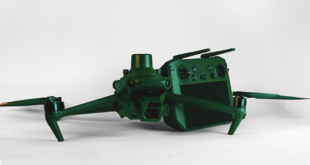DRONELIFE honors talented people and innovative companies of all types – and we try to do our part to promote diversity in the industry. March 8, 2019 is International Women’s Day, so we reached out to women and men in all areas of the industry to get their thoughts on the challenges of building a balanced workforce – and the successes that women are finding in the industry.
It’s no secret that the numbers of women in the drone industry – and the aerospace industry as a whole – are surprisingly low. In 2017 we published an article that estimated the percentage of women drone pilots at 4%: in October 2018, The Verge published an article which upped the percentage to a meager 5%. These numbers are so low as to be shocking, except for the fact that they are only a bit lower than the percentage of women in the aviation and aerospace industries in general. (Women represent only 6% of licensed airplane pilots, for example, Women in Aviation International reports.)
“Women And Drones just analyzed the most recent pilot statistics released by the Federal Aviation Administration,” says Wendy Erikson, host of the Women and Drones podcast. “Since the enactment of the small drone rule by the FAA in August of 2016, more than 100,000 people have obtained the Remote Pilot Airman Certificate which allows them to fly a drone for both commercial and recreational purposes. The number of women on that list has been growing, up to 6,188 according to the FAA’s latest count. Still, that number indicates females make up only 5.8% of the total certificated remote pilot population. As in other areas of the aviation industry, the representation of women is very low.”
Compared to other areas of aviation, the drone industry appears to be easier to break into – so why aren’t the numbers larger? It’s a complex and difficult question – one without a single answer. “One of the most encouraging things I’m seeing in the drone industry, is the number of women from around the world joinining up in exclusive social media groups to support and encourage each other in what can be a difficult, male-dominated field,” says Loretta Alkalay, drone pilot, aviation attorney and Adjunct Professor at Vaughn College of Aeronautics and Technology. “What remains perplexing and discouraging is how few women there are despite how low the barriers to entry are compared to other aviation fields. “
An Outsized Impact
While the numbers are low, there is definitely some reason for hope: that small percentage of women is having an outsized impact on the industry. Looking at some of the biggest players in the aerospace and defence industries, four of the top firms have a woman at the very top of the organization. “By next year, three of the top U.S. defense firms — Lockheed Martin Corp., General Dynamics Corp. and most recently, Northrop Grumman Corp. — will have a female CEO. And Boeing Co. has had a woman at the helm of its $21-billion defense, space and security business since 2016,” reports HeraldNet.
In the drone industry specifically, many women are taking leadership roles – and acting as major industry influencers. For example, the top two spots at Insitu, a Boeing company, are taken by women: President and CEO Esina Alic and Chief Financial Officer Rita McMullen. Leading drone solutions platform PrecisionHawk may be the most balanced, boasting a leadership team where women occupy 6 out of the 13 top positions. There are countless women like Dyan Gibbens, the founder and CEO of leading drone services company Trumbull Unmanned, who have started their own businesses in the industry. Women like Gretchen West and Lisa Ellman, founding members of Women of Commercial Drones (with Dyan Gibbens, mentioned above) and Diana Cooper, PrecisionHawk’s SVP of Policy and Strategy, have had major impact on drone regulations as active participants of industry coalitions and government partnerships.
Still, there is a much longer – and not to be published here – list of companies whose leadership teams have no women at all, or only one on a team of 10 or more. “In general, the environment is positive as the FAA statistics show a substantial increase in year over year Women Remote Pilots,” says Sharon Rossmark, CEO of Women and Drones. “However, the opportunity still exists to hire more women drone pilots as well as increasing the number of women in key leadership, decision making roles.”
Why Diversity is Good for the Drone Industry
That diversity is good for the drone, or any, industry is something most companies – with leaders of any gender – can agree upon. The lack of women in the industry isn’t necessarily because the jobs aren’t available.
“The industry needs the boldest and brightest contributors to promote its growth and ensure longevity. Women are fundamental in building a true community,” says Randall Warnas, Global sUAS Segment Leader at thermal imaging giant FLIR. Marc Gandillon, Marketing Director at Swiss company Flyability, says that the company is making an effort to take on more women interns and generate more female applicants. “As a manufacturer, we look for all kinds of engineering professionals and we hired massively over the last two years. We received very few applications [from women] and over the same period we had 3 young and talented women joining the company for internships.”
Lisa Murray, Director of Diversified Communications, the company that produces Commercial UAV Expo in the U.S. and Europe, says that a balanced workforce creates better product. “Having a team that is diverse not only in terms of gender but also background, culture and experience can open the team up to different opinions and ways of looking at challenges,” says Murray. “A homogenous team can breed “more of the same” thinking rather than challenging assumptions. A diverse team will almost always result in a better-considered, more broadly appealing product.” Gary Buchanon, Chief Operating Officer at drone services company Avisight, agrees. Avisight is actively seeking to diversify their workforce. (By the way, they’re hiring.) “Any time you create diversity in an industry, you get different perspectives to put into play and you come up with greater and better solutions,” says Buchanon.
Challenges
The jobs may be out there, but there are definitely challenges for women working in a male dominated field. It’s up to companies to ensure that their environments are healthy and comfortable for all of their employees. Reports of inappropriate behavior in the field – either racing or commercial work, or inappropriate comments on forums, unfortunately abound. Perception that women can’t drone seems to persist in some areas of the industry.
The good news for women interested in the industry is the growing number of resources available for support and networking. “Within the past year I have heard of several new women and drone networking, resource and STEM organizations helping women and girls in the drone community,” says Belinda Betancourt Dow, principal at Dow GeoSpatial.
“Women are a very small part of the drone industry -it is encouraging to see a growing acceptance and invitation for women to be involved,” says Desi Ekstein, of On the Go Video. “There are many new opportunities and ways to participate. I personally am involved with several: “Girls Take Flight” program has been a huge success for giving young ladies an opportunity to become UAS pilots, and I have seen more STEM projects like this evolving.”
When they can, women should attend drone conferences – and take the opportunity to connect with other women in the industry. Commercial UAV Expo was one of the first to sponsor a women’s networking event at their conference; since then the idea has taken off. “We want to enable and facilitate the creation of more groups and resources for women, and that happens in various ways at our event, Commercial UAV Expo Americas,” says Lisa Murray. “We will again be featuring some conference programming and networking opportunities for women involved in the drone industry.”
The Future of the Industry
The voices above come from all areas of the industry, and they indicate that while the numbers are still low, there are opportunities for women in drones. However, in order to achieve real equality in the workforce, the industry will need to start earlier – supporting STEM education and drone training for girls who may someday fill leadership positions.
“Through more exposure and education, engagement and recruitment, we hope to see progress continue when it comes to narrowing the gender gap in the drone industry,” says Wendy Erikson of Women and Drones.
Miriam McNabb is the Editor-in-Chief of DRONELIFE and CEO of JobForDrones, a professional drone services marketplace, and a fascinated observer of the emerging drone industry and the regulatory environment for drones. Miriam has a degree from the University of Chicago and over 20 years of experience in high tech sales and marketing for new technologies.
Email Miriam
TWITTER:@spaldingbarker
Subscribe to DroneLife here.
https://dronelife.com/2019/03/08/dronelife-exclusive-why-women-are-important-to-the-drone-industry/
 Unmanned Aerial Vehicle The latest drone news
Unmanned Aerial Vehicle The latest drone news




